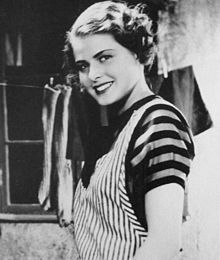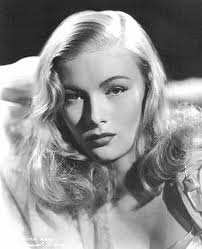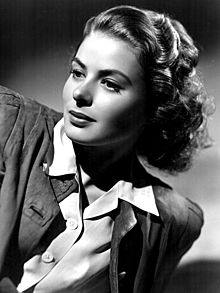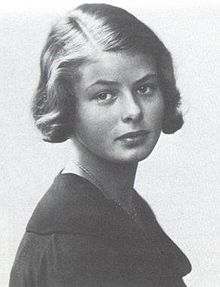Ingrid Bergman

Hollywood Collection: Ingrid Bergman Remembered

Ingrid Bergman was a wonderful actress and an amazing person. This video is a present for her and for all her fans. It is a tribute to someone who was not afraid to live. Here I only put a few of the things I would say to her, actually, what we all fans would say to her. As her 96th birthday present, love you Ingrid!! I hope you all enjoy.
Ingrid Bergman, 1940
Ingrid Bergman (29 August 1915 – 29 August 1982) was a Swedish actress who starred in a variety of European and American films. She won three Academy Awards, two Emmy Awards, and the Tony Award for Best Actress. She is ranked as the fourth greatest female star of American cinema of all time by the American Film Institute. She is best remembered for her roles as Ilsa Lund in Casablanca (1942), a World War II drama co-starring Humphrey Bogart and as Alicia Huberman in Notorious (1946), an Alfred Hitchcock thriller co-starring Cary Grant.
Before becoming a star in American films, she had already been a leading actress in Swedish films. Her first introduction to American audiences came with her starring role in the English remake of Intermezzo in 1939. In America, she brought to the screen a “Nordic freshness and vitality”, along with exceptional beauty and intelligence, and according to the St. James Encyclopedia of Popular Culture, she quickly became “the ideal of American womanhood” and one of Hollywood’s greatest leading actresses.
After her excellent performance in Victor Fleming’s remake of Dr. Jekyll and Mr. Hyde in 1941, she was noticed by her future producer David O. Selznick, who called her “the most completely conscientious actress” he had ever worked with. He gave her a seven-year acting contract, thereby supporting her continued success. A few of her other starring roles, besidesCasablanca, included For Whom the Bell Tolls (1943), Gaslight (1944), The Bells of St. Mary’s(1945), Alfred Hitchcock‘s Spellbound (1945), Notorious (1946), and Under Capricorn (1949), and the independent production, Joan of Arc (1948).
In 1950, after a decade of stardom in American films, she starred in the Italian film Stromboli, which led to a love affair with director Roberto Rossellini while they were both already married. The affair and then marriage with Rossellini created a scandal that forced her to remain in Europe until 1956, when she made a successful Hollywood return in Anastasia, for which she won her second Academy Award, as well as the forgiveness of her fans. Many of her personal and film documents can be seen in the Wesleyan University Cinema Archives.
Early years: 1915–1938
Bergman, named after Princess Ingrid of Sweden, was born in Stockholm, Sweden on 29 August 1915 to a Swedish father, Justus Samuel Bergman, and a German mother, Friedel (Adler) Bergman. When she was three years of age, her mother died. Her father, who was an artist and photographer, died when she was thirteen. In the years before he died, he wanted her to become an opera star, and had her take voice lessons for three years. But she always “knew from the beginning that she wanted to be an actress”, sometimes wearing her mother’s clothes and staging plays in her father’s empty studio. Her father documented all her birthdays with a borrowed camera.
 Her first film, Munkbrogreven (1934) at age 19.
Her first film, Munkbrogreven (1934) at age 19.
After his death, she was then sent to live with an aunt, who died of heart complications only six months later. She then moved in with her Aunt Hulda and Uncle Otto, who had five children. Another aunt she visited, Elsa Adler, first told Ingrid, when she was 11, that her mother may have “some Jewish blood”, and that her father was aware of that fact long before they married. But her aunt also cautioned her about telling others about her possible ancestry as “there might be some difficult times coming.”
At the age of 17, Bergman was allowed only one chance to become an actress by entering an acting competition with the Royal Dramatic Theatre in Stockholm. Bergman recalls her feelings during that competition:
- “As I walked off the stage, I was in mourning, I was at a funeral. My own. It was the death of my creative self. My heart had truly broken… they didn’t think I was even worth listening to, or watching.”
However, her impression was wrong, as she later met one of the judges who described how the others viewed her performance:
- “We loved your security and your impertinence. We loved you and told each other that there was no reason to waste time as there were dozens of other entrants still to come. We didn’t need to waste any time with you. We knew you were a natural and great. Your future as an actress was settled.”
 As a result she received a scholarship to the state-sponsored Royal Dramatic Theatre School, where Greta Garbo had years earlier also earned a similar scholarship. After a few months she was given a part in a new play, Ett Brott (A Crime), by Sigfrid Siwertz. Yet, this was “totally against procedure” at the school, notes Chandler, where girls were expected to complete three years of study before getting such acting roles. During her first summer break, she was also hired by a Swedish film studio, which consequently led to her leaving the Royal Dramatic Theatre to work in films full time, after just one year. Her first film role after leaving the Royal Dramatic Theatre was a small part in 1935’s Munkbrogreven (She had previously been an extra in the 1932 film Landskamp). She later acted in a dozen films in Sweden, including En kvinnas ansikte, which was later remade as A Woman’s Face with Joan Crawford, and one film in Germany, Die vier Gesellen(“The Four Companions”) (1938).
As a result she received a scholarship to the state-sponsored Royal Dramatic Theatre School, where Greta Garbo had years earlier also earned a similar scholarship. After a few months she was given a part in a new play, Ett Brott (A Crime), by Sigfrid Siwertz. Yet, this was “totally against procedure” at the school, notes Chandler, where girls were expected to complete three years of study before getting such acting roles. During her first summer break, she was also hired by a Swedish film studio, which consequently led to her leaving the Royal Dramatic Theatre to work in films full time, after just one year. Her first film role after leaving the Royal Dramatic Theatre was a small part in 1935’s Munkbrogreven (She had previously been an extra in the 1932 film Landskamp). She later acted in a dozen films in Sweden, including En kvinnas ansikte, which was later remade as A Woman’s Face with Joan Crawford, and one film in Germany, Die vier Gesellen(“The Four Companions”) (1938).
Hollywood period: 1939–1949 – Intermezzo: A Love Story (1939)
 Bergman’s first acting role in America came when Hollywood producer David O. Selznick brought her to America to star in Intermezzo: A Love Story, an English language remake of her 1936 Swedish film, Intermezzo. Unable to speak English and uncertain about her acceptance by the American audience, she expected to complete this one film and return home to Sweden. Her husband, Petter, remained in Sweden with their daughter Pia. In the film she played the role of a young piano accompanist opposite Leslie Howard as a famous violin virtuoso.
Bergman’s first acting role in America came when Hollywood producer David O. Selznick brought her to America to star in Intermezzo: A Love Story, an English language remake of her 1936 Swedish film, Intermezzo. Unable to speak English and uncertain about her acceptance by the American audience, she expected to complete this one film and return home to Sweden. Her husband, Petter, remained in Sweden with their daughter Pia. In the film she played the role of a young piano accompanist opposite Leslie Howard as a famous violin virtuoso.
She arrived in Los Angeles on 6 May 1939, and stayed at the Selznick home until she could find another residence. According to David Selznick’s son Danny, who was a child at the time, his father had a few concerns about Ingrid: “She didn’t speak English, she was too tall, her name sounded too German, and her eyebrows were too thick.” However, Bergman was soon accepted without having to modify her looks or name, despite some early suggestions by Selznick. He let her have her way”, notes a story in Life Magazine. Selznick understood her fear of Hollywood make-up artists, who might turn her into someone she wouldn’t recognize, and “instructed them to lay off.” He was also aware that her natural good looks would compete successfully with Hollywood’s “synthetic razzle-dazzle.”
During the weeks following, while Intermezzo was being filmed, Selznick was also filming Gone with the Wind. In a letter to William Herbert, his publicity director, Selznick described a few of his early impressions of Bergman:
- “Miss Bergman is the most completely conscientious actress with whom I have ever worked, in that she thinks of absolutely nothing but her work before and during the time she is doing a picture … She practically never leaves the studio, and even suggested that her dressing room be equipped so that she could live here during the picture. She never for a minute suggests quitting at six o’clock or anything of the kind… Because of having four stars acting in Gone with the Wind, our star dressing-room suites were all occupied and we had to assign her a smaller suite. She went into ecstasies over it and said she had never had such a suite in her life… All of this is completely unaffected and completely unique and I should think would make a grand angle of approach to her publicity… so that her natural sweetness and consideration and conscientiousness become something of a legend… and is completely in keeping with the fresh and pure personality and appearance which caused me to sign her…”
 With Humphrey Bogart in Casablanca
With Humphrey Bogart in Casablanca
Intermezzo became an enormous success and as a result Bergman became a star. The film’s director, Gregory Ratoff, said “She is sensational”, as an actress. This was the “sentiment of the entire set”, writes Life, adding that workmen would go out of their way to do things for her, and the cast and crew “admired the quick, alert concentration she gave to direction and to her lines.” Film historian David Thomson notes that this would become “the start of an astonishing impact on Hollywood and America” where her lack of makeup contributed to an “air of nobility.” According toLife, the impression that she left on Hollywood, after she returned to Sweden, was of a tall (5 ft. 9 in.) girl “with light brown hair and blue eyes who was painfully shy but friendly, with a warm, straight, quick smile.” Selznick appreciated her uniqueness, and with his wife Irene, they remained important friends throughout her career.
Casablanca (1942)
After Germany initiated World War II, Bergman “felt guilty because she had so misjudged the situation in Germany” while she was there filming Die vier Gesellen (The Four Companions). According to one of her biographers, Charlotte Chandler (2007), she had at first considered the Nazis only a “temporary aberration, ‘too foolish to be taken seriously.’ She believed Germany would not start a war.” Bergman felt that “The good people there would not permit it.” Chandler adds, “Ingrid felt guilty all the rest of her life because when she was in Germany at the end of the war, she had been afraid to go with the others to witness the atrocities of the Nazi extermination camps.”
After completing one last film in Sweden and appearing in three moderately successful films (Adam Had Four Sons, Rage in Heaven and Dr. Jekyll and Mr. Hyde, all in 1941) in the United States, Bergman co-starred with Humphrey Bogart in the 1942 classic film Casablanca, which remains her best-known role. In this film, she played the role of Ilsa, the beautiful Norwegian wife of Victor Laszlo, played by Paul Henreid, an “anti-Nazi underground hero” who is in Casablanca, a safe-haven from the Nazis. Bergman did not consider Casablanca to be one of her favorite performances. “I made so many films which were more important, but the only one people ever want to talk about is that one with Bogart.” In later years however, she stated, “I feel about Casablanca that it has a life of its own. There is something mystical about it. It seems to have filled a need, a need that was there before the film, a need that the film filled.”
For Whom the Bell Tolls (1943)
 After Casablanca, with “Selznick’s steady boosting”, she played the part of Maria in For Whom the Bell Tolls (1943), which was also her first color film. For the role she received her first Academy Award nomination for Best Actress. The film was taken from Ernest Hemingway‘s novel of the same title. When the book was sold to Paramount Pictures, Hemingway stated that “Miss Bergman, and no one else should play the part.” His opinion came from seeing her in her first American role, Intermezzo, although he hadn’t yet met her. A few weeks later, they did meet, and after studying her he said “You are Maria!”
After Casablanca, with “Selznick’s steady boosting”, she played the part of Maria in For Whom the Bell Tolls (1943), which was also her first color film. For the role she received her first Academy Award nomination for Best Actress. The film was taken from Ernest Hemingway‘s novel of the same title. When the book was sold to Paramount Pictures, Hemingway stated that “Miss Bergman, and no one else should play the part.” His opinion came from seeing her in her first American role, Intermezzo, although he hadn’t yet met her. A few weeks later, they did meet, and after studying her he said “You are Maria!”
Gaslight (1944)
 Publicity photo for film Gaslight (1944)
Publicity photo for film Gaslight (1944)
The following year, she won the Academy Award for Best Actress for Gaslight (1944), a film in which George Cukor directed her as a “wife driven close to madness” by co-star Charles Boyer. The film, according to Thomson, “was the peak of her Hollywood glory.” Bergman next played a nun in The Bells of St. Mary’s (1945) opposite Bing Crosby, for which she received her third consecutive nomination for Best Actress.
Hitchcock films
Bergman starred in the Alfred Hitchcock films Spellbound (1945), Notorious (1946), and Under Capricorn (1949). Unlike her earlier Hitchcock films, Under Capricorn, the only one of the three made in colour, was a slow-paced costume drama, and has never received the acclaim that the other films that Bergman made with Hitchcock have. Bergman was a student of the acting coach Michael Chekhov during the 1940s. Coincidentally, it was for his role in Spellbound that Chekhov received his only Academy Award nomination.
Joan of Arc (1948)
 Later, Bergman received another Best Actress nomination for Joan of Arc (1948), an independent film based on the Maxwell Anderson play Joan of Lorraine, produced by Walter Wanger, and initially released through RKO. Bergman had championed the role since her arrival in Hollywood, which was one of the reasons she had played it on the Broadway stage in Anderson’s play. The film was not a big hit with the public, partly because of the scandal of Bergman’s affair with Italian film director Roberto Rossellini, which broke while the film was still in theatres. Even worse, it received disastrous reviews, and although nominated for several Academy Awards, did not receive a Best Picture nomination. It was subsequently shorn of 45 minutes, and it was not until its restoration to full length in 1998 and its 2004 appearance on DVD that later audiences could see it as it was intended to be shown.
Later, Bergman received another Best Actress nomination for Joan of Arc (1948), an independent film based on the Maxwell Anderson play Joan of Lorraine, produced by Walter Wanger, and initially released through RKO. Bergman had championed the role since her arrival in Hollywood, which was one of the reasons she had played it on the Broadway stage in Anderson’s play. The film was not a big hit with the public, partly because of the scandal of Bergman’s affair with Italian film director Roberto Rossellini, which broke while the film was still in theatres. Even worse, it received disastrous reviews, and although nominated for several Academy Awards, did not receive a Best Picture nomination. It was subsequently shorn of 45 minutes, and it was not until its restoration to full length in 1998 and its 2004 appearance on DVD that later audiences could see it as it was intended to be shown.
Between motion pictures, Bergman appeared in the stage plays Liliom, Anna Christie, and Joan of Lorraine. Furthermore, during a press conference in Washington, D.C. for the promotion of Joan of Lorraine, she protested against segregation after seeing it first hand at the theater she was acting in. This led to a lot of publicity and some hate mail.
Bergman went to Alaska during World War II to entertain American troops. Soon after the war ended, she also went to Europe for the same purpose, where she was able to see the devastation caused by the war. It was during this time that she began a relationship with the famous photographer Robert Capa. She became a smoker after needing to smoke for her role in Arch of Triumph.



